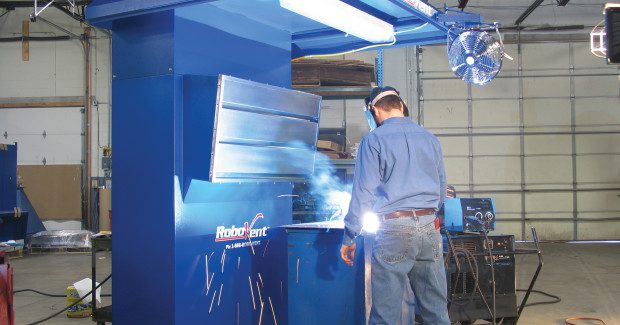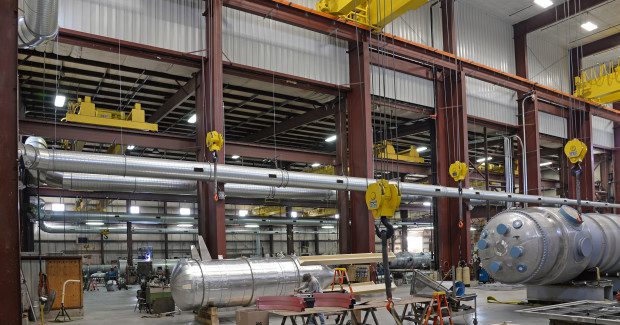Is Source Capture Enough? Looking at Ambient Options
You already have source capture systems in place for your welding operations. Do you also need an ambient air quality system? If your air isn’t as clean as it should be, you might want to consider it.
Posted: February 2, 2016
Source capture is an excellent choice for many applications; used correctly in environments where the fume source location doesn’t move, source methods can capture 95 percent or more of particulates. But if you are relying on source capture for large parts or for manual welders who move around as they complete their jobs, it might not be enough on its own. In the past, capturing 50 percent to 70 percent of fumes at the source may have been considered “good enough.” However, regulations for air quality are tightening. Many companies are already moving to stricter ACGIH recommendations in order to prepare themselves for tomorrow and improve recruiting and retention. Meeting these tighter standards may require the addition of an ambient system.
WHEN SOURCE CAPTURE ISN’T ENOUGH
Source capture systems fall into several categories, each with their strengths and weaknesses.
- Fume arms consist of movable hoods that are manually positioned over the weld arc. As the welder moves along the weld seam, the fume arm needs to be repositioned as well. Used correctly, they are highly efficient (roughly 95 percent) at capturing fumes in their immediate vicinity. However, welders often do not take the time to reposition the fume arm, as this slows down the welding process. Real-world observations suggest that capture efficiency may only be 30 percent to 50 percent in actual practice.
- Fume guns are nozzles attached directly to the welding gun that suck up fumes as soon as they are created. While highly effective, most existing technologies are heavy and cumbersome to use in manual welding. Under ideal use, they may capture up to 95 percent of generated fumes, but in typical practice the capture rate may only be 50 percent to 70 percent. As the welder moves with the fume gun to new areas or components, just-welded parts will still emit fumes for some time. Once the welder moves on, there is no source capture for the still-smoking parts.
- Fume hoods are often used for large parts. The part can be placed inside the hood, which captures fumes as they rise. This is highly effective at keeping fumes from spreading to other parts of the facility, though the hoods do not necessarily offer protection for welders working inside them.
- Backdraft or downdraft tables can be used for small components that are kept in one place during the welding process, and when set up properly can be very effective. However, when parts get larger than the design anticipated, or man-cooling fans are used in the summer months, they capture some, but not all, of the fumes produced, and a certain percentage will manage to escape before they can be captured.
Unless they are used under the ideal, design conditions, most source capture methods will allow some portion of weld fumes to escape into the ambient air, where they can spread far from the welding station. Adding an ambient system will remove the fumes that source capture methods miss, and help to further protect the workers in the facility.
AMBIENT SYSTEM OPTIONS
In considering an ambient system, there are a few different options to consider. The simplest method is simply to use ventilation fans to blow contaminated air out the roof and pull fresh air in. However, while cheaper to install initially, this type of ventilation system can lead to huge energy losses in hot or cold weather. It may also put your company out of compliance with EPA regulations. A better long-term answer is a system that cleans and returns air to the facility. There are three basic options to look for:
- Ducted push-pull systems are the most traditional. They rely on a system of ducts up near the ceiling, located at roughly 50 ft intervals. In each area, smoke rising from the welding stations is pulled into ductwork on one side and clean air is pushed in from ducts on the other side. This creates air currents in the building that continually pull contaminated air away from personnel and into the system. Dust collectors use powerful filtration to clean particulates out of the air before returning it to the facility. Ducted systems keep the air quality equipment off of the floor and out of the way; dust collectors can be placed overhead or outside of the building. These systems may be ideal for large facilities that need ambient air capture throughout.
- Ductless systems rely on standalone dust collectors that sit on the factory floor. Each dust collector creates its own circular local airflow pattern, pulling dirty air in and pushing clean air out. For example, Vortex has nozzles that can be adjusted directionally to maximize efficiency. It creates a plant-wide environmental vortex that turns the air at a consistent rate. Ductless systems can be positioned where they are needed around the factory floor. They are easier to install, eliminate expensive ductwork, and have a higher airflow per unit. And in addition, the system can be expanded or moved to a different location very easily.
- A new option will soon be available: a ductless ceiling mounted system that combines the advantages of a ductless system with the floor space savings of a traditional push-pull system. It eliminates the ductwork, so it’s easier to install. Units are placed near the ceiling, where they collect weld fumes before they have a chance to fall back out of the air.
PLANNING THE BEST SYSTEM FOR YOUR FACILITY
How do you know which option is best for you? First, you have to analyze your facility. Up front planning and analysis can save both time and money. The goal is to find the solution that provides you with the air quality you want with the most efficiency and least cost. That requires understanding the existing air quality problems and airflow patterns within the facility. Before installing an ambient system, you will first want to make sure that you are maximizing the efficiency of your existing source capture solutions. Are they being used appropriately? Do you need to make changes to your processes or modify your equipment settings to increase the volume of fumes captured? But if you are still experiencing air quality issues, it may be time to consider an ambient system to help.
A ventilation systems engineer can analyze your existing state and design the best system for your unique facility and applications. Analysis needs to consider:
- Current air quality at different points in the facility and the exposure levels for workers in each area
- The composition and volume of weld fumes generated and type of welding being done (e.g. manual vs. robotic)
- The size and type of equipment being welded and the efficacy of current source capture methods
- The facility layout and specifications (e.g. number and location of welding stations, existing ventilation and HVAC equipment, locations of doors and windows, etc.)
- The current air flow patterns in the facility
Computer modeling can help with this analysis. Engineers use computer models to analyze the current airflow patterns and design solutions that work with the airflow, not against it. Modeling can help to identify problems areas and predict the impact of potential remedies before going to the expense of putting them in place. Done right, it will help avoid over- or under-engineering of the solution, so you can be sure that you are getting the results you need without overspending on unnecessary equipment. Clean air is a valuable asset your employees will appreciate. Combining ambient and source capture systems may be the right solution to get you there.






